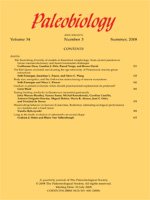Abundant fossil plant remains are preserved in the high-latitude middle Eocene deposits of the Buchanan Lake Formation on Axel Heiberg Island, Nunavut Territory, Canada. Intact leaf litter, logs, and stumps preserved in situ as mummified remains offer an opportunity to determine the structure, biomass, and productivity of two Taxodiaceae-dominated forests that grew north of the Arctic Circle (paleolatitude 75–80°N). We excavated fossil tree trunks and treetops to develop equations that describe the height, structure, and mass of the aboveground components of Eocene-age Metasequoia trees. We combined those data with surveys of in situ stumps to determine the structure, biomass, and productivity of two fossil forests, “N” and “HR.” We calculated a canopy height of 40 ± 3 m for the N forest and 25 m ± 2 m for the HR forest. Buried knots in dissected logs and abundant branch-free bole wood indicate that these were tall, closed-canopy forests. Stem tapers indicate that the overstory was of uniform height. Stem volume equaled 2095 m3 ha−1 and stem biomass was 628 Mg ha−1 in the N forest. Volume and biomass in the HR forest were much smaller, 211 m3 ha−1 and 63.3 Mg ha−1, respectively. We estimated understory tree biomass to be 40 Mg ha−1 in the N forest and 3.5 Mg ha−1 in the HR forest. Recovery of seven fossil treetops with exposed branch stubs enabled us to make estimates of branchwood and foliar biomass using allometric equations derived from modern, plantation-grown Metasequoia glyptostroboides. Estimated stand-level branch biomass was 13 and 6.7 Mg ha−1 in the N and HR forests, respectively. Standing foliar biomass was estimated to be 3.2 and 2.1 Mg ha−1 in the N and HR forests, respectively. Using annual ring widths, the reconstructed parabolic stems, and wood density of modern Metasequoia, we calculated annual wood production to be 2.3 Mg ha−1 yr−1 for the N forest and 0.55 Mg ha−1 yr−1 for the HR forest Assuming that the ancient Metasequoia were deciduous like their living relatives, annual aboveground net primary productivity was 5.5 Mg ha−1 yr−1 for the N forest and 2.8 Mg ha−1 yr−1 for the HR forest. Our estimated biomass and productivity values for N are similar to those of modern old-growth forests of the Pacific Northwest of the United States and old-growth coastal Cordillera forests of southern Chile.
How to translate text using browser tools
1 June 2003
Reconstruction of Tertiary Metasequoia forests. II. Structure, biomass, and productivity of Eocene floodplain forests in the Canadian Arctic
Christopher J. Williams,
Arthur H. Johnson,
Ben A. LePage,
David R. Vann,
Tatsuo Sweda
ACCESS THE FULL ARTICLE





